Upload
In this article, we will show you step-by-step how to upload the files you will use to train your model. You can upload your own images or use images from Unsplash, a proprietary stock photography website that OSAI has partnered with.
If you want to upload your own images, prepare the files you will use beforehand. OSAI accepts both .jpg and .png formats. You can select images one at a time from the system location, or you can add folders and .zip directories in bulk. If you want to use Unsplash images, follow the steps in the Unsplash article.
To show you how to upload your own images, we will use Toys – a demo dataset used solely for illustration purposes. It is a perfect example to demonstrate how the application works.
For a visual guide, check out the tutorial on our Youtube channel:
Create the data directory
Before adding files, you need to create a directory where you will store and manage the images. To do this, click on the Datasets tab in the menu and select Owned.
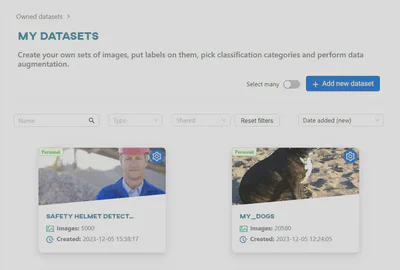
To upload files, click Add new dataset.
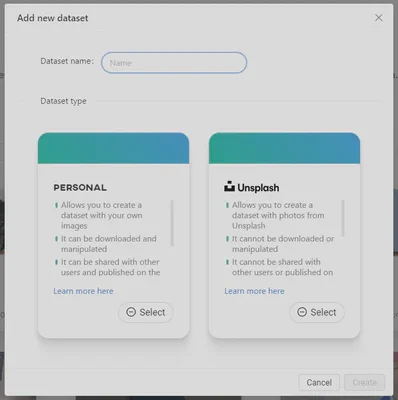
Select the Personal dataset type, enter a name, and then click Create.
The dataset name must be unique, with a minimum of 3 and a maximum of 50 characters. When creating a dataset name, use only letters from the Latin alphabet, numbers and hyphens.
Images uploading
Once the dataset is added, you can manage it from the management view. At the top of the screen, there are 4 options for uploading:
Add directory- to upload an entire directory,Add files- to upload individual files,Add archive- to upload a .zip file,Live from camera- to upload images from a camera stream.
The supported resolutions range from 8x8 to 4069x3112.
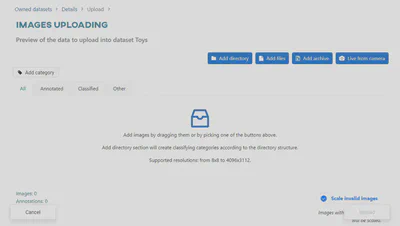
Add directory
First use the Add directory option, which will create the classification categories based on the directory structure. This will upload an entire directory containing the files you need.
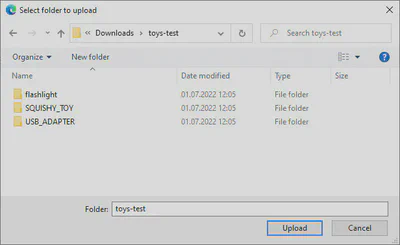
When you click Add Directory, a system window will open. Find the folder you want to use and select it. Then click Upload.

Some browsers (usually Microsoft Edge) may ask for additional permission to upload multiple files. Agree by clicking the Upload button.
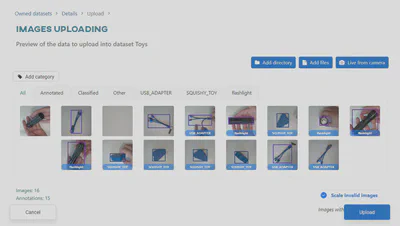
Once the request has been processed, you will see a preview of the images being added to the database.
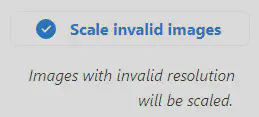
ONESTEP AI has some limitations on the size of uploaded images, so you will need to decide what should happen to images outside the resolution range. You can select or deselect the Scale invalid images option. For this tutorial, it does not matter whether you select this option or not.

Now, the actual upload will start. You can go and do something else in the app, but it is necessary to keep the tab open. When the upload is complete, you will see a notification at the top of the screen. Clicking on it will redirect you to the dataset management screen.
Do not close the OSAI page while uploading. Doing so will interrupt and terminate the upload process.
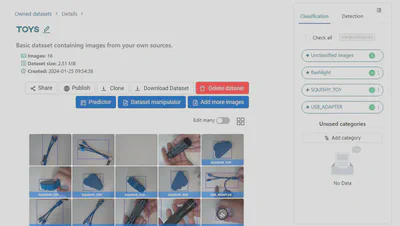
Here you can go through the dataset view and see if anything is missing. If more images are needed, you can always upload additional files using the Add more images button.
Adding a .zip
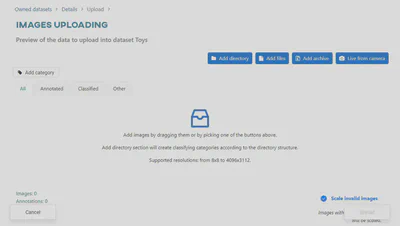
Add directory is not the only way to add multiple files at once. ONESTEP AI also accepts .zip files that can be added using the Add archive button.

Clicking the button will open a system window. Select the .zip file and click Open.
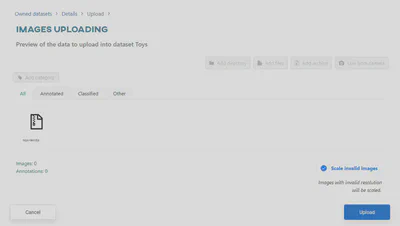
When you see a preview of your file, click Upload at the bottom of the screen.
Adding categories
In the images uploading view, you have the option to add new categories as needed. To do this, simply click the Add category button.

In the pop-up window, enter the category name and confirm by clicking Ok.
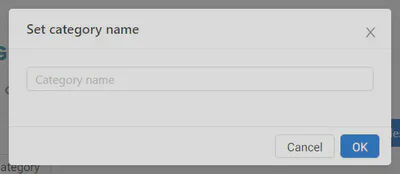
Your category should now appear on one of the tabs.

You can edit the category or delete only the category and keep the images or delete the category with all the images in it.